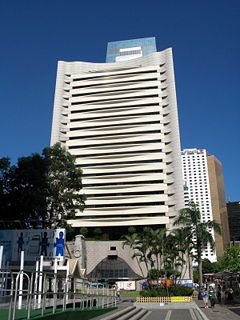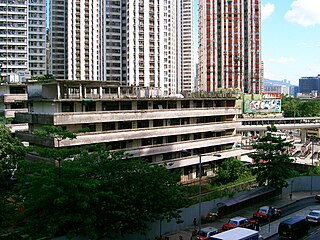
Dairy Farm International Holdings Limited is a Hong Kong retail company with its legal base in Bermuda. A member of the Jardine Matheson Group, it is a major pan-Asian retailer involved in the processing and wholesaling of food and personal hygiene products in the Pacific region and in China. Jardine Strategic, a publicly listed holding company, has an attributable 78 percent stake in the firm. It is listed on the London Stock Exchange, with secondary listings on the Singapore and Bermuda stock exchanges.

798 Art Zone, or Dashanzi Art District, is a complex of 50-year-old decommissioned military factory buildings boasting a unique architectural style that houses a thriving artistic community in Dashanzi, Chaoyang District of Beijing. The area is often called the 798 Art District or Factory 798 although technically, Factory #798 is only one of several structures inside the complex formerly known as 718 Joint Factory. The buildings are within alleys number 2 and 4 on Jiǔxiānqiáo Lù (酒仙桥路), south of the Dàshānziqiáo flyover (大山子桥). The area is anchored by the UCCA Center for Contemporary Art, the largest and most visited venue in the area. In recent years, it has been the main venue for the annual Beijing Queer Film Festival and Beijing Design Week.

Chater House is an office tower in Central, Hong Kong. Opened in 2003, it is a part of the Hongkong Land portfolio of properties. It has a three-level retail podium, known as Landmark Chater. The building was built on the site of the former Swire House, and was named after Sir Paul Chater. The building faces streets on three sides: Chater Road, Pedder Street and Connaught Road Central.

The Hong Kong Club Building is a 25-story office building located in between Chater Road and Connaught Road Central at the junction of Jackson Road, in Central, Hong Kong. The Hong Kong Club Building is currently in its third generation, in its second location. It is owned by the Hong Kong Club, which occupies 8 levels, while the other floors are leased for office use.

Cheung Sha Wan is an area between Lai Chi Kok and Sham Shui Po in New Kowloon, Hong Kong. It is mainly residential to the north and south, with an industrial area in between. Administratively it is part of Sham Shui Po District which includes Lai Chi Kok as well.

Tuen Mun New Town, commonly referred to simply as Tuen Mun, is a satellite town of Hong Kong. It is one of the new towns that were developed by the Hong Kong Government in the New Territories from the 1960s. It was built around the existing rural local centre of Tuen Mun. The town is currently regulated by the Tuen Mun Outline Zoning Plan. Land leases in this area were known as Tuen Mun Town Lot № foo. The new town covers most of the urban area of Tuen Mun District. Another new town, Hung Shui Kiu, which is located partially in Tuen Mun District, is currently under development.

The Standard Chartered Bank Building is a skyscraper located in Central, Hong Kong. The tower rises 42 storeys and 191 metres (627 ft) in height. The building was completed in 1990. It was designed by architectural firm P & T Architects & Engineers Ltd..
China Aerospace International Holdings Limited is a Hong Kong incorporated holding company. The company itself is a subsidiary of China Aerospace Science and Technology Corporation and a listed company on the Stock Exchange of Hong Kong. It is a red chip company, but not part of the "red chip index" of the stock exchange.

Jordan Valley Factory Estate was a factory estate in Jordan Valley, Ngau Tau Kok, Kowloon, Hong Kong, owned and managed by the Hong Kong Housing Authority. It was built in 1959. In 1983, its west wing was demolished to construct the new Ngau Tau Kok Bus Terminus. The remaining buildings were cleared in 2004 and demolished in 2005.

The following is a list of public housing estates in Chai Wan and Siu Sai Wan, Hong Kong, including Home Ownership Scheme (HOS), Private Sector Participation Scheme (PSPS), Sandwich Class Housing Scheme (SCHS), Flat-for-Sale Scheme (FFSS), and Tenants Purchase Scheme (TPS) estates.
The following is a list of public housing estates in Tsuen Wan, Hong Kong, including Home Ownership Scheme (HOS), Private Sector Participation Scheme (PSPS), Sandwich Class Housing Scheme (SCHS), Flat-for-Sale Scheme (FFSS), and Tenants Purchase Scheme (TPS) estates.

The following is a list of public housing estates in Yuen Long New Town, Hong Kong, including Home Ownership Scheme (HOS), Private Sector Participation Scheme (PSPS), Sandwich Class Housing Scheme (SCHS), Flat-for-Sale Scheme (FFSS), and Tenants Purchase Scheme (TPS) estates.

Cattle Depot Artist Village is located on 63 Ma Tau Kok Road, Ma Tau Kok, Kowloon, Hong Kong, China. The site was originally used as a slaughterhouse from 1908 to 1999. It was renovated and developed into a village for artists in 2001. It is now home to around 20 art groups.
Manufacturing in Hong Kong consists of mainly light and labour-intensive industries. The manufacturing industry started in the 19th century after the Taiping Rebellion and continues today, although it has largely been replaced by service industries, particularly the finance and real estate industries.

The Jockey Club Creative Arts Centre is a multi-disciplinary arts centre in Shek Kip Mei, Hong Kong, housed in a converted nine-storey factory estate.
The Hong Kong Arts Development Council (ADC) is a statutory body in Hong Kong tasked with development of the arts in the territory.

Public factory estates are blocks of factory buildings owned by the Government of Hong Kong. Built between the late 1950s and the early 1980s, most of these industrial buildings have been demolished during the 1990s and 2000s, while some have been converted and a few are still active. While these buildings are notable as witnesses of the history of manufacturing in Hong Kong and of the public housing policy of the Government of Hong Kong, they represent only a fraction of the industrial buildings of the territory: there were about 1,700 industrial buildings in Hong Kong in 2003.
The scheme of revitalisation of industrial buildings was announced by the Government of Hong Kong in 2009. The aims of the scheme is to provide more floor spaces for suitable uses in order to meet Hong Kong’s changing social and economical needs. The scheme was implemented since April 1, 2010. There was a mid-term review of the scheme in September 2011. Afterwards, the deadline for submission of applications was extended from March 31, 2013 to March 31, 2016.
Handicraft markets in Hong Kong provide a platform for artists and craftspeople to show or sell their original artistic works. They are growing in range and popularity, but remain restricted by the availability of venues.
Olivia Yan is a Hong Kong theatre playwright, director, actress, teacher and writer. With more than 20 years of experience in stage production, performance and theatre management, she has attracted batches of students eager to study under her.
















